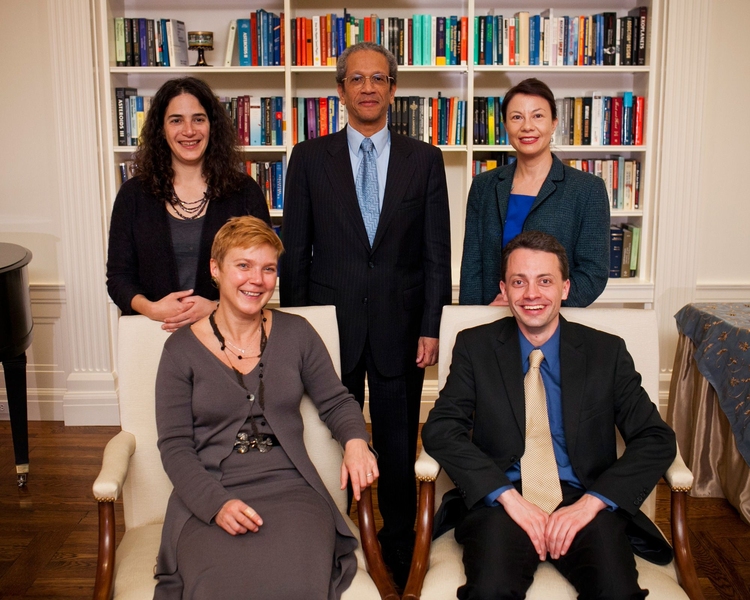Attendees at the MacVicar Day celebration on Friday, March 15, became participants in an online-learning experiment led by Associate Professor of Mechanical Engineering Anette “Peko” Hosoi. She asked the crowd in Bartos Theatre, “What is the first image that appeared in my Google search for ‘online digital learning’?”
Hosoi instructed those with laptops or mobile phones to go to the website m.socrative.com to record both their answer to the multiple-choice question and their degree of confidence in their response.
“If you use this tool to guide your lectures, the question about confidence can give you more valuable feedback,” Hosoi said. (And the correct response, she later revealed, was a photograph of Sanjay Sarma, MIT’s director of digital learning.)
MacVicar Day is an annual event held to celebrate the new MacVicar Faculty Fellows. The MacVicar Program was established in 1992 to commemorate Margaret MacVicar '64, ScD '67, MIT’s first dean for undergraduate education and founder of the Undergraduate Research Opportunities Program. This year’s event was a symposium titled “Reimagining the MIT Classroom: Experiments With Digital Learning.”
In addition to Hosoi, who is a MacVicar Fellow, speakers at the event included: Jesús del Alamo, the Donner Professor of Electrical Engineering and MacVicar Fellow; Anne McCants, professor of history and MacVicar Fellow; Troy van Voorhis, professor of chemistry; and newly appointed MacVicar Faculty Fellow Emma Teng, an associate professor of China studies and the T.T. and Wei Fong Chao Professor of Asian Civilizations. Daniel Hastings, the dean for undergraduate education and the Cecil and Ida Green Education Professor of Engineering Systems and Aeronautics and Astronautics, moderated the symposium.
The founder and principal investigator of the iLab Project at MIT, del Alamo discussed his investigations into the potential of online, remotely operated laboratories in education. He demonstrated the Amplitude Modulation iLab, which permits students to tune various controls and observe the behavior and changes of relevant signals, both in time domain and frequency domain.
Online labs provide “many opportunities for students to make mistakes, to waste their time — and as a result, to learn,” del Alamo said, continuing that the systems powering them must continually be maintained and upgraded or else they will die. He likened the steps of developing an online lab — from concept to prototype to use inside and beyond MIT — to pushing a rock uphill; “If you stop, the rock will roll over you.” According to del Alamo, “We need to find a way to nurture new ideas to the point where they can be given serious scrutiny by the administration for eventual adoption.”
McCants used a period engraving of the 16th-century Battle of the Solent, the largest invasion force ever to reach British shores, to illustrate how cartography could be merged with digital techniques to triangulate and confirm the veracity of events described in source material. She cautioned that while the digitally enhanced classroom can foster a much broader conversation by including different voices from across the world, there is the danger of the “nasty effect” that results from online conversations getting vitriolic.
“History is a discipline of inclusion and exclusion ... the history classroom is actually a very fragile place, where many wars have started,” McCants said. “Our task for the next five years is to figure out how to reap the benefits of the wider conversation without letting it run wild.”
Van Voorhis described how molecular structure kits can be replaced by three-dimensional visualization apps that students can download and manipulate; how a show of hands in the classroom can be replaced by clickers (“less embarrassing” for the students); and how, when his lectures run over time, he posts the remaining lecture notes on MITx along with asking a question online to reinforce concepts.
But, according to van Voorhis, whether in the classroom or online, content delivery needs to be interactive in order to be effective. It’s important to interrupt the lecture to ask students if they have questions, and to ask questions of the students — in other words, “derail the firehose or else I don't find out they're not following.” It is much harder for students to ask questions online, he said, and wondered if it was possible to design machine-gradable problems that test deep understanding of concepts.
In her course “Global Chinese Migration since 1567,” Teng experimented with digital tools and online learning to enhance and improve residential education. Using the Ning social networking platform, she incorporated weekly themes, group discussions, extensions of content and expansion of the syllabus to frame and explain the importance of readings. Students, whom she described as “consumers and producers of content,” could upload photos that relate to the readings, choose images of artifacts they want to discuss, and assemble them into their own albums. She referred to this model as a “small, closed, online classroom,” in contrast to MOOCs (massive open online courses).
Teng told of former students who have mailed her materials after encountering Chinese migrant groups from around the world. They have continued their work after they've completed the class, and even beyond MIT. She praised blogs as a vehicle, saying that students are interested in writing them and expressing themselves.
The speakers were followed by a lively question-and-answer session covering topics such as collaboration, assessment (“It's a lot easier to assess whether knowledge has been transmitted than it is to assess whether wisdom was acquired,” said McCants), and how to keep online content fresh. According to van Voorhis, “Online repositories make the process of pedagogy accumulative; you build on things that are already there.”
McCants summed up the afternoon by saying, “You can use digital tools well, or use them badly; it's the choices you make.” Moderator Hastings thanked the participants for their “excellent and provocative set of ideas.”
The 2013 MacVicar Fellows are Teng; Linda Griffith, the School of Engineering Teaching Innovation Professor of Biological and Mechanical Engineering; Rob Miller, associate professor of computer science and engineering; and Laura Schulz, the Class of 1943 Career Development Associate Professor of Cognitive Science.






